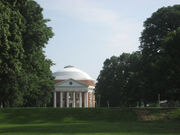
The Rotunda in 2004, prior to roof renovations (photo courtesy Tim Jarrett)
The Rotunda is a building located on The Lawn in the original grounds of the University of Virginia. It was designed by Thomas Jefferson to represent the "authority of nature and power of reason" and was inspired by the Pantheon in Rome. Construction began in 1822 and was completed in 1826, after his death. The grounds of the new university were unique in that they surrounded a library housed in the Rotunda rather than a church, as was common at other universities in the English-speaking world. The Rotunda is seen as a lasting symbol of Jefferson's belief in the separation of church and education, as well as his lifelong dedication to both education and architecture.
The collegiate structure, the immediate area around it, and Jefferson's nearby home at Monticello combine to form one of only three modern man-made sites in the United States to be internationally protected and preserved as a World Heritage Site by UNESCO (the other two are the Statue of Liberty and Independence Hall).
The original construction cost of the Rotunda was $57,773 ($992,792 in 2006 dollars). The building stands 77 feet (23.5 m) in both height and diameter.
History
Design and construction
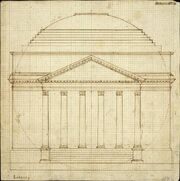
1819 draft of the Rotunda
During the Marquis de Lafayette's grand tour of the United States in 1824 and 1825, the Marquis and former President James Madison dined with Thomas Jefferson in the Dome Room of the unfinished Rotunda at the University's inaugural banquet, and Lafayette toasted Jefferson as the "Father of the University of Virginia". This moved Jefferson, and he later had the phrase inscribed on his grave. A bust of Lafayette was given to the University in 1904 by the Government of France to honor the friendship between the two men. Today it stands in the North Oval Room.
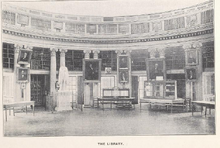
Library in the Rotunda, 1892 Corks and Curls
During the first century of the University, the Rotunda served as the library for the institution. The Dome Room of the Rotunda, occupying the top floor of the Rotunda, held book cases on the ground floor that occupied the space between the inner columns and the outer walls, as well as on the mezzanine level. The Dome Room also held the Galt statue of Mr. Jefferson.
The University being the first at which students could specialize in the field of Astronomy, Jefferson toyed with the idea of painting the interior of the Dome Room with images of the night sky to aid the students in their learning. He went so far as to begin designing a new mechanism with which students would be able to "float" through the air and study heavenly bodies from closer different viewpoints. They would also be equipped with a control to move the stars around the Dome. The idea was eventually abandoned but would have been the first planetarium in the United States. The Transit of Venus of 1882 was observed from the steps of the Rotunda, in a coordinated effort with McCormick Observatory.
Alterations
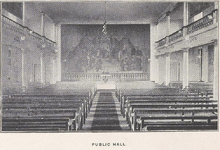
The Public Hall in the Rotunda Annex, from the 1892 Corks and Curls
A structure called the Annex, also known as "New Hall," was added to the north side of the Rotunda in 1853 to provide additional classroom space needed due to overcrowding.[1] The Annex was primarily occupied by the Public Hall, a large lecture space whose most prominent feature was a large copy of the Raphael painting "The School of Athens." The Public Hall was the site of one of the earliest documented concerts of the Virginia Glee Club, the Openings Concert on December 17, 1891.
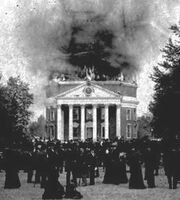
The Great Rotunda Fire, 1895
On October 27, 1895, the Rotunda was entirely gutted by a disastrous fire that started in the Annex.[2] University students saved what was, for them, the most important item within the Rotunda — a life-size likeness of Mr. Jefferson carved from marble that was given to the University by Alexander Galt in 1861; the students also rescued a portion of the books of the University library from the Dome Room, as well as various scientific instruments from the classrooms in the Annex. Shortly after the fire, the faculty drew up a recommendation to the Board of Visitors, recommending a program of rebuilding that called for the reconstruction of the Rotunda and the replacement of the lost classroom space of the Annex with a set of buildings at the south end of the Lawn.[3] In the new design, the wooden dome was replaced with a fireproof tile dome by the Guastavino Company of New York in 1898-1899. The Rotunda was rebuilt with a modified design by Stanford White, a nationally known architect and head of a firm in New York City. Whereas Jefferson's Rotunda had three floors, White's had only two, but a larger Dome Room. In addition, the Annex was not rebuilt.
In 1976 during America's Bicentennial, White's Rotunda interior was gutted and completely rebuilt, at a cost of $2.4 million, to Jefferson's original design. In the Bicentennial issue of the AIA Journal, the American Institute of Architects called Jefferson's Rotunda, Lawn, and nearby home at Monticello "the proudest achievement of American architecture in the past 200 years".[4]
There is a plaque, on the south side of the Rotunda, listing the names of students and graduates of The University who were killed during the Civil War. Other plaques on the south side list those killed during World War I while plaques on the north side list those killed in World War II and the Korean War.

Renovation underway on the Rotunda in 2011, with the Jefferson statue in the foreground
Today, doctoral students defend their dissertations in the North Oval Room, and many events (including monthly dinners for residents of the Lawn) are held inside the Dome Room. Other important events are held on the steps of the Rotunda, which is also the traditional starting point for students streaking the Lawn.
In 2012, the University began an extensive construction project to repair and renovate the aging Rotunda.[5] The first phase of the project will replace the Rotunda's copper roof. Although the engineers were several months ahead of schedule, the roof remained an unpainted copper for the graduating class of 2013.[6] The project is slated to finish in 2016.
Legacy
Most notably designed by inspiration of the Rotunda and Lawn are the expansive green spaces headed by Rotunda-like buildings built at Duke University in 1892, Johns Hopkins University in 1902, Rice University in 1910, Peabody College of Vanderbilt University in 1915, the Green at the University of Delaware in 1916, Killian Court at MIT in 1916 and the "Grand Auditorium" of Tsinghua University in Beijing built in 1917. Additionally, Dallas Hall at Southern Methodist University (SMU), Hendricks Chapel at Syracuse University, and Grawemeyer Hall at the University of Louisville were modeled after Jefferson's Rotunda.
The original campus at the University of Alabama was modeled after Jefferson's Rotunda and Lawn. The Rotunda there, completed in 1833, also contained the university's library. However, it and all other public campus buildings were burned during the Civil War.[7][8]
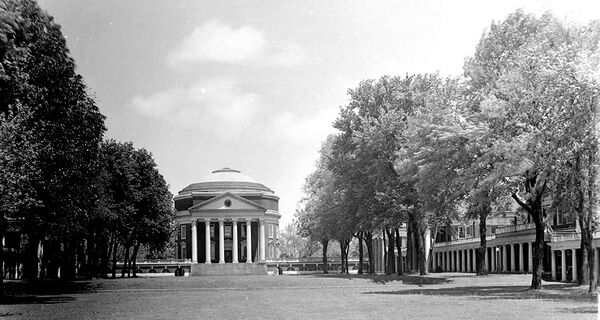
Today's view from The Lawn to Jefferson's Rotunda is virtually unchanged from this 1914 image
References
- ↑ "So You Want to Be a UGuide?". http://www.student.virginia.edu/~uguides/join/join.php?section=info. Retrieved 2008-03-20.
- ↑ "The Rotunda: History". Archived from the original on 2013-06-15. http://web.archive.org/web/20130615000000*/http://www.virginia.edu/uvatours/rotunda/rotundaHistory.html. Retrieved 2014-06-26.
- ↑ Bruce, Philip Alexander (1921). History of the University of Virginia, 1819-1919: The Lengthened Shadow of One Man. New York: MacMillan. pp. 257–272. http://books.google.com/books?id=ns0zAAAAIAAJ&printsec=frontcover&dq=editions:0BLxWloAaoujinN78oyz9F1#PPA254,M1.
- ↑ AIA Journal, 65 (July 1976), p. 91
- ↑ "The Rotunda - The Campaign for the University of Virginia". http://www.virginia.edu/giving/campaign/programs-projects/capital-projects/the-rotunda/. Retrieved 06-05-2013.
- ↑ "Inclement Weather Leads to Unique Distinction for Class of 2013". 2013-05-22. http://news.virginia.edu/content/inclement-weather-leads-unique-distinction-class-2013. Retrieved 2013-10-15.
- ↑ "University of Alabama Rotunda 1859". Encyclopedia of Alabama. http://encyclopediaofalabama.org/face/Multimedia.jsp?id=m-2838. Retrieved 2009-12-04.
- ↑ Center, Clark E. (1990). "The Burning of the University of Alabama". Alabama Heritage Spring 1990 (16): 30–45. http://www.alabamaheritage.com/vault/UAburning.htm.
External links
- Live webcam
- UVa's Rotunda web page
- Academical Village map
- Tales in the Rotunda's Past (includes cow on the roof)
| This page uses Creative Commons Licensed content from Wikipedia (view authors). |
